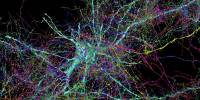For the first time, Oregon Health & Science University researchers have revealed the function of a little-understood junction between cells in the brain, which could have important treatment implications for conditions ranging from multiple sclerosis to Alzheimer’s disease to glioma, a type of brain cancer.
The findings were published in Nature Neuroscience.
Neuroscientists concentrated on the synapse, or junction, that connects neurons to non-neuronal cells known as oligodendrocyte precursor cells, or OPCs. OPCs can differentiate into oligodendrocytes, which create myelin, a coating that surrounds neurons. Myelin is the protective coating that surrounds each nerve cell’s axon, which is the threadlike component of the cell that carries electrical signals between them.
The study found that these synapses play a pivotal role in producing that myelin.
This is the first investigation of these synapses in live tissue. This provides insight into the underlying features of how these cells function during normal development. In the future, we might investigate how they behave differently in the context of MS patients.
Kelly Monk
“This is the first investigation of these synapses in live tissue,” stated senior author Kelly Monk, Ph.D., professor and co-director of the Vollum Institute at OHSU. “This provides insight into the underlying features of how these cells function during normal development. In the future, we might investigate how they behave differently in the context of MS patients.”
The existence of these synapses was the subject of a breakthrough discovery made by OHSU researchers at the Vollum and published in the journal Nature in May 2000. Until then, synapses in the brain were only known to transport neurotransmitters between neurons, therefore the finding of a synapse between neurons and OPCs came as a surprise.
“After two decades, we still didn’t know what these synapses do,” Monk said.
Scientists tackled the problem by using single-cell imaging of live tissue in zebrafish, whose transparent bodies enable researchers to see the inner workings of their central nervous system in real time. Using powerful new tools in imaging, pharmacology, and gene editing, researchers were able to use neuron-OPC synapses to predict the timing and location of the formation of myelin.

The findings are likely the tip of the iceberg in terms of understanding the importance of these synapses, said lead author Jiaxing Li, Ph.D., a postdoctoral fellow in Monk’s lab.
Oligodendrocyte precursor cells comprise about 5% of all cells in the brain — meaning the synapses they form with neurons could be relevant to many disease conditions, including the formation of cancerous tumors.
Li added that prior research has revealed that OPCs have a role in a variety of neurodegenerative ailments, including demyelinating disorders like MS, neurodegenerative diseases like Alzheimer’s, and even psychiatric disorders like schizophrenia.
Li believes that by demonstrating the basic function of the synapse between neurons and OPCs, the study could lead to novel strategies of manipulating OPC function to affect disease development. For example, these synapses could be critical in encouraging remyelination in diseases like MS, when myelin has been damaged. In MS, this degeneration can impede or block the electric signals that allow people to see, move their muscles, feel sensations, and think.
“There may be a way to intervene so that you can increase the myelin sheath,” he said.
Monk believes the discovery may be most immediately relevant to cancer.
“In glioma, these synapses are hijacked to drive tumor progression,” she went on to say. “It may be possible to modulate the synaptic input involved in tumor formation, while still allowing for normal synaptic signaling.”
Even though these precursor cells account for around 5% of all human brain cells, only a small proportion develop into oligodendrocytes.
“It’s becoming pretty clear that these OPCs have other functions aside from forming oligodendrocytes,” Monk went on to say. “From an evolutionary perspective, it doesn’t make sense to have so many of these precursor cells in your brain if they’re not doing something.”
Their synaptic link to neurons so likely performs a basic role in the brain and is worthy of further investigation, she stated.
















